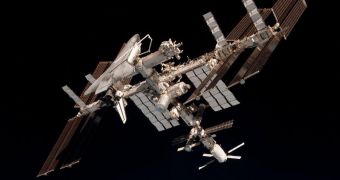Officials from the European Space Agency (ESA) announced that one of their Automated Transfer Vehicles (ATV) aboard the International Space Station (ISS) was just used to modify the orbital facility's path in its orbit.
The ATV, called Johannes Kepler, carried out there successful reboost maneuvers, during which it fired its thrusters to boost the ISS to a higher orbit around the planet. The 417-ton orbital lab was moved from an altitude of 345 to 380 kilometers above the surface.
This will ensure that the lab is set in the optimum position for conducting studies in the coming decades. Recently, the space agencies and nations involved in the ISS project decided to expand the station's operations by at least 2020.
With the new maneuver, the ISS' fuel consumption has been cut by no less than 50 percent. Its thrusters now need to fire less often than before, in order to maintain the correct orbit, and compensate for naturally-occurring orbital decays.
Over the coming years, space agencies will only send half of the initially-planned fuel to the ISS. The ATV played an essential role in making this a reality, and ESA is very proud of its contribution to the project thus far.
“These reboosts will improve ISS scientific exploitation enormously, since we'll need to send much less fuel into orbit, making more launch capacity available for spare parts, scientific instruments and supplies,” explains the leader of the ESA ATV Program, Nico Dettmann.
“Yes, this means a saving for the ISS but an increased usage for the visiting vessels. Nonetheless, a significantly larger tonnage of food, water, spare parts and research instruments and samples can be sent up, keeping the Station operational until 2020 and beyond,” he adds.
Since the US-built space shuttles will be retired next month, the station will only be visited by space capsules for5 the foreseeable future. ESA operates its ATV, and the Russian Federal Space Agency (RosCosmos) has its Soyuz and Progress capsules.
The Japan Aerospace Exploration Agency (JAXA) can also supply the ISS, with its H-II Transfer Vehicles (HTV). In a few years, the US will again have the ability to visit the station, when private space companies start producing efficient private spacecraft.
“With the end of the shuttle era, the Station's orbit can be optimized at a higher level, which helps all partners make most efficient use of the orbiting outpost's unique scientific capabilities,” Dettmann adds.
“We really are quite pleased that ATV can help out like this. It's truly a marvelous vessel,” he concludes.

 14 DAY TRIAL //
14 DAY TRIAL //